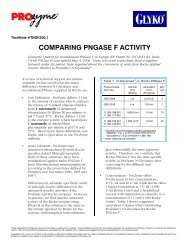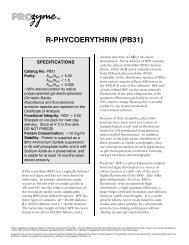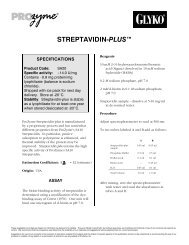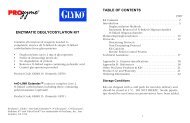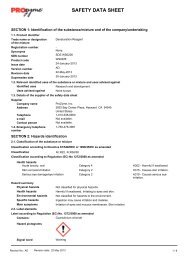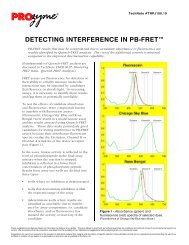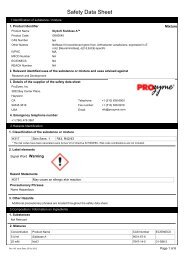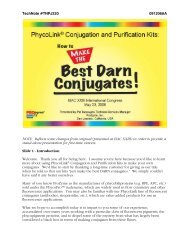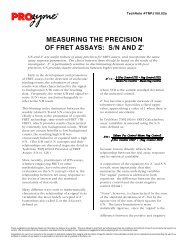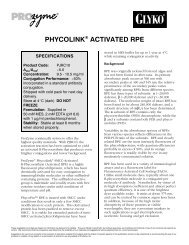WS0024 SDS - ProZyme
WS0024 SDS - ProZyme
WS0024 SDS - ProZyme
Create successful ePaper yourself
Turn your PDF publications into a flip-book with our unique Google optimized e-Paper software.
According to Regulation (EC) No. 1272/2008Language : English8. Exposure Controls/Personal ProtectionSafety Data Sheet1. Control ParametersNo Data Available2. Exposure ControlsGeneral protective andhydgiene measuresEngineering measuresEye / Face ProtectionHand protectionRespiratory protectionSkin protectionOther personal protectionadviceP280: Wear protective gloves/protective clothing/eye protection/face protection.Handle in accordance with good industrial hygiene and safety practice. Wash hands before breaksand at the end of workday.Safety glasses with side-shields. Use equipment for eye protection tested and approved underappropriate government standards such as NIOSH (US) or EN 166(EU).Handle with gloves. Gloves must be inspected prior to use. Use proper glove removal technique(without touching glove's outer surface) to avoid skin contact with this product. Dispose ofcontaminated gloves after use in accordance with applicable laws and good industrial hygienepractices. Wash and dry hands.P261: Avoid breathing dust/fume/gas/mist/vapours/spray.For nuisance exposures use type P95 (US) or type P1 (EU EN 143) particle respirator. For higherlevel protection, use type OV/AG/P99 (US) or type ABEK-P2 (EU EN 143) respirator cartridges. Userespirators and components tested and approved under appropriate government standards such asNIOSH (US) or CEN (EU).Complete suit protecting against chemicals, The type of protective equipment must be selectedaccording to the concentration and amount of the dangerous substance at the specific workplace.NA9. Physical and Chemical Properties1. Physical and Chemical PropertiesAppearanceOdourOdour thresholdPHMelting point / Freezing pointInitial boiling point and boiling rangeFlash pointEvaporation rateFlammability(solid,gas)Upper/lower flammability or explosive limitsVapour pressureVapour densityRelative densitySolubility(ies):Partition coefficient: n-octanol/waterAuto-ignition temperatureDecomposition temperatureViscosityExplosive propertiesOxidising properties2. Other InformationNo data available.10. Stability and Reactivity1. ReactivityNo data available.2. StabilityStable under recommended storage conditions.3. Possibility of Hazardous Reactionsoff-white powderNo Data AvailableNo Data AvailableNo Data AvailableMelting point range: 111 - 113°C - litNo Data Available198°C - closed cupNo Data AvailableNo Data AvailableNo Data AvailableNo Data AvailableNo Data AvailableNo Data AvailableNo Data AvailableNo Data AvailableNo Data AvailableNo Data AvailableNo Data AvailableNo Data AvailableNo Data AvailablePage 3 of 6
According to Regulation (EC) No. 1272/2008Language : EnglishSafety Data SheetNo data available.4.Conditions to AvoidProtect from light. Avoid oxidizing agents.5. Incompatible MaterialsOxidizing agents.6. Hazardous Decomposition ProductsHazardous decomposition products formed under fire conditions: carbon oxides, nitrogen oxides (NOx).Other decomposition products - no data available11. Toxicology information1. InformationAcute ToxicitySkin corrosion/irritationSerious eyeDamage/irritationRespiratory or skinsensitisationGerm Cell mutagenicityCarcinogenicityNo data available.May be harmful if absorbed through skin. May cause skin irritation.May cause eye irritation.May be harmful if inhaled.No data available.IARC: No component of this product present at levels greater than or equal to 0.1% is identified asprobable, possible or confirmed human carcinogen by IARC.ACGIH: No component of this product present at levels greater than or equal to 0.1% is identified asa carcinogen or potential carcinogen by ACGIH.OSHA: No component of this product present at levels greater than or equal to 0.1% is identified asa carcinogen or potential carcinogen by OSHA.Reproductive toxicitySTOT-single exposureSTOT-repeated exposureAspiration hazardNo data available.Specific target organ toxicity - single exposure (Globally Harmonized System): Inhalation - Maycause respiratory irritation.No data available.No data available.2. AdditionalRTECS: CU8993000To the best of our knowledge, the chemical, physical and toxicological properties have not been thoroughly investigated.12. Ecological Information1. ToxicityNo data available.2. Persistance and degradabilityNo data available.3. Bio-Accumulative PotentialNo data available.4. Mobility and SoilNo data available.5. Results of PBT & vPvB assessmentNo data available.6. Other adverse effectsNo data available.13. Disposal Considerations1. Waste Treatment MethodsDisposal OperationsDisposal of PackagingOffer surplus and non-recyclable solutions to a licensed disposal company. Contact a licensedprofessional waste disposal service to dispose of this material. Dissolve or mix the material with acombustible solvent and burn in a chemical incinerator equipped with an afterburner and scrubber.Dispose of as unused product.14. Transport InformationAir (ICAO)Page 4 of 6
According to Regulation (EC) No. 1272/2008Language : English1. UN Number:2. Shipping Name: None Hazardous3. Transport hazard class(es): : Sub Class :Safety Data Sheet4. Packing group:5. Environmental hazards:6. Special Precautions for user:7. Transport in bulk:Road (ADR)1. UN Number:2. Shipping Name: None Hazardous3. Transport hazard class(es): : Sub Class :4. Packing group:5. Environmental hazards:6. Special Precautions for user:7. Transport in bulk:Sea (IMDG)1. UN Number:2. Shipping Name: None Hazardous3. Transport hazard class(es): : Sub Class :4. Packing group:5. Environmental hazards:6. Special Precautions for user:7. Transport in bulk:15. Safety, health, environmental and national regulations1. Safety, health, environmental and national regulations:Page 5 of 6
According to Regulation (EC) No. 1272/2008Language : EnglishSafety Data SheetOSHA HazardsHarmful by ingestion, skin irritantSARA 302 ComponentsNo chemicals in this material are subject to the reporting requirements of SARA Title III, Section 302.SARA 313 ComponentsThis material does not contain any chemical components with known CAS numbers that exceed the threshold (De Minimis)reporting levels established by SARA Title III, Section 313.SARA 311/312 HazardsAcute Health HazardMassachusetts Right To Know ComponentsNo components are subject to the Massachusetts Right to Know Act.Pennsylvania Right To Know ComponentsAnthranilamide CAS-No. 88-68-6New Jersey Right To Know ComponentsAnthranilamide CAS-No. 88-68-6California Prop. 65 ComponentsThis product does not contain any chemicals known to State of California to cause cancer, birth defects, or any otherreproductive harm.2. Safety AssessmentNo Chemical Safety Assessment16. Other Information1. Other Information:ADR: Accord Europeen sur le transport des merchandises Dangereuses par Route(European Agreement concerning theInternational Carriage of Dangerous Goods by road)RID:Reglement International concernant le transport des merchandises dangereuses par chemin de fer (Regulations concerning theInternational transport of Dangerous Goods by Rail)IMDG: International Maritime Code for Dangerous GoodsIATA: International Air Transport AssociationIATA-DGR: Dangerous Goods Regulations by the International Air Transport AssociationGHS: Globally Harmonized System of Classification and Labelling of ChemicalsCAS:Chemical Abstracts Service2. Associated risk phrases according to european directive 67/548/EECR20/21/22 Harmful by inhalation, in contact with skin and if swallowed.R20/22 Harmful by inhalation and if swallowed.R21/22 Harmful in contact with skin and if swallowed.R22Harmful if swallowed.R36Irritating to eyes.R36/37 Irritating to eyes and respiratory system.R36/37/38 Irritating to eyes, respiratory system and skin.R36/38 Irritating to eyes and skin.R37Irritating to respiratory system.R37/38 Irritating to respiratory system and skin.R38Irritating to skin.R42/43 May cause sensitization by inhalation and skin contact.R43May cause sensitisation by skin contact.R68/20/21/22 Harmful: possible risk of irreversible effects through inhalation, in contact with skin and if swallowed.R68/20/22 Harmful: possible risk of irreversible effects through inhalation and if swallowed.R68/21/22 Harmful: possible risk of irreversible effects in contact with skin and if swallowed.3. DisclaimerThe product listed is for research and development purposes only and not for human or animal use. As such, in most cases, thetoxicological, ecological and physicochemical properties have not been fully determined and the product should be treated withrespect and always handled under suitable conditions by appropriately qualified personnel. The responsible party shall use thisdatasheet only in conjunction with other sources of information gathered by them, and should make an independent judgement ofsuitability, to ensure proper use and protect the health and safety of employees. This information is furnished without warranty andany use of the product not in conformance with this material safety data sheet, or in combination with any other product or process,is the responsibility of the user.Page 6 of 6



